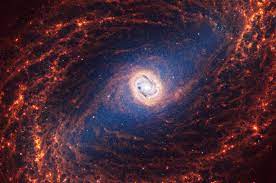“James Webb Telescope Reveals Breathtaking Images: 19 Spiral Galaxies Captivate the Cosmos”
In a breathtaking revelation, NASA’s James Webb Telescope has shared a collection of stunning images showcasing 19 spiral galaxies near the Milky Way. Captured through the Physics at High Angular resolution in Nearby GalaxieS (PHANGS) project, these images provide a captivating insight into the intricate process of star formation and the evolution of galaxies.


In a breathtaking revelation, NASA’s James Webb Telescope has shared a collection of stunning images showcasing 19 spiral galaxies near the Milky Way. Captured through the Physics at High Angular resolution in Nearby GalaxieS (PHANGS) project, these images provide a captivating insight into the intricate process of star formation and the evolution of galaxies.
The recently released photos, resembling brilliant pinwheels, present a detailed view of the galaxies’ structure and offer a novel perspective on how stars come into being. According to scientists involved in the PHANGS project, the images suggest that galaxies grow from the inside out, indicating that star formation initiates at the center of the galaxy and gradually spreads outward through its spiral arms.
Janice Lee, the project scientist for strategic initiatives at the Space Telescope Science Institute in Baltimore, expressed her awe at the images, stating, “The JWST’s new images are extraordinary. They’re mind-blowing even for researchers who have studied these same galaxies for decades. Bubbles and filaments are resolved down to the smallest scales ever observed and tell a story about the star formation cycle.”
The Mid-Infrared Instrument (MIRI) of the James Webb Space Telescope played a crucial role in capturing these mesmerizing images, showcasing bright orange dust lanes and recording stars in the process of development within their gas and dust envelopes. The envelopes, resembling red “seeds” atop the peaks of dust lanes, highlight the ongoing formation of stars within these cosmic wonders.
The closest galaxy captured in these images is approximately 15 million light-years from Earth, while the farthest distant galaxy lies approximately 60 million light-years away. The depiction of galaxies growing from the inside out challenges previous assumptions and provides a valuable contribution to our understanding of the cosmos.
Ms. Lee explained, “The images are not only aesthetically stunning, they also tell a story about the cycle of star formation and feedback, which is the energy and momentum released by young stars into the space between stars.” She emphasized that the images reveal explosive activity and clearing of dust and gas on various scales, offering a dynamic insight into the overall star formation cycle.
These captivating images not only appeal to scientific curiosity but also make the complex process of star formation accessible to the public. Ms. Lee concluded, “The dynamic process of the overall star formation cycle becomes obvious and qualitatively accessible, even for the public, which makes the images compelling on many different levels.”
The release of these images marks another milestone in our exploration of the cosmos, providing a visual feast and valuable scientific insights that contribute to the ongoing dialogue about the mysteries of the universe.
Sources By Agencies




